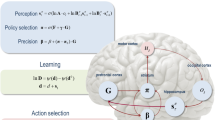Abstract
This paper describes a new generator of symbolic traces which is designed for the latest version of the insertion modeling system. The basic characteristics of the generator are the use of graphic representations of descriptions of multilevel models, division of local descriptions and consequence relation, possibility of adjustment to different search strategies, and application of a new predicate transformer that admits generality quantifiers with constraints relaxed relative to the previous versions.
Similar content being viewed by others
References
D. R. Gilbert and A. A. Letichevsky, “A universal interpreter for nondeterministic concurrent programming languages,” in: 5th Compulog Network Area Meeting on Language Design and Semantic Analysis Methods, Aachen (1996), p. 14.
A. Letichevsky and D. Gilbert, “A general theory of action languages,” Cybernetics and System Analysis, 34, No. 1, 12–30 (1998).
A. Letichevsky and D. Gilbert, “A model for interaction of agents and environments,” Lecture Notes in Computer Science, 1827, 311–328 (1999).
R. Milner, A Calculus of Communicating Systems, Springer, Berlin–Heidelberg–New York (1980).
R. Milner, Communication and Concurrency, Prentice Hall, NJ (1989).
R. Milner, “The polyadic π-calculus: A tutorial,” Tech. Rep. ECS-LFCS-91-180, No. 180, 91–180 (1991).
C. A. R. Hoare, Communicating Sequential Processes, Prentice Hall, NJ (1985).
J. A. Bergstra and J. W. Klop, “Process algebra for synchronous communications,” Information and Control, No. 60 (1/3), 109–137 (1984).
Luca Cardelli and Andrew D. Gordon, “Mobile Ambients,” in: Foundations of Software Science and Computational Structures, Lecture Notes in Computer Science, 1378, 140–155 (1998).
C. A. Petri, Kommunikation mit Automaten, Schriften des IIM Nr. 2, Institut fur Instrumentelle Mathematik, Bonn (1962).
C. Hewitt, P. Bishop, and R. Steiger, “A Universal Modular Actor Formalism for Artificial Intelligence,” in: 3rd International Joint Conference on Artificial intelligence, Stanford (1973), pp. 235–245.
A. Letichevsky, “Algebra of behavior transformations and its applications,” Structural Theory of Automata, Semigroups, and Universal Algebra, NATO Science Series II, Mathematics, Physics, and Chemistry, No. 207, 241–272 (2005).
Yu. V. Kapitonova and A. A. Letichevsky, “Insertion modeling,” in: Proc. Intern. Conf. “50 years of V. M. Glushkov Institute of Cybernetics,” Vyd-vo IK NANU, Kyiv (2008), pp. 293–301.
S. Baranov, C. Jervis, V. Kotlyarov, A. Letichevsky, and T. Weigert, “Leveraging UML to deliver correct telecom applications in UML for Real,” in: Design of Embedded Real-Time Systems (2003), pp. 323–342.
J. Kapitonova, A. Letichevsky, V. Volkov, and T. Weigert, Validation of Embedded Systems, CRC Press, Miami (2005).
A. Letichevsky, J. Kapitonova, A. Letichevsky Jr., V. Volkov, S. Baranov, V. Kotlyarov, and T. Weigert, “Basic protocols, message sequence charts, and the verification of requirements specifications,” in: Workshop on Integrated Reliability with Telecommunications and UML Languages (Rennes, 4 November, 2005), Elsevier (2005), p. 42.
A. Letichevsky, J. Kapitonova, A. Letichevsky Jr., V. Volkov, S. Baranov, V. Kotlyarov, and T. Weigert, “Basic protocols, message sequence charts, and the verification of requirements specifications,” Computer Networks, No. 47, 662–675 (2005).
A. Ad. Letichevsky, Yu. V. Kapitonova, V. A. Volkov, A. A. Letichevsky, S. N. Baranov, V. P. Kotlyarov, and T. Weigert, “System specification with basic protocols,” Cybernetics and System Analyses, 41, No. 4, 479–493 (2005).
A. Letichevsky, O. Letychevskyi, and V. Peschanenko, “Insertion modeling system,” Lecture Notes in Computer Science, 7162, 262–274 (2011).
A. A. Letichevsky, “Insertion modeling,” USiM, No 6, 3–14 (2012).
A. Letichevsky, J. Kapitonova, V. Kotlyarov, A. Letichevsky Jr, N. Nikitchenko, V. Volkov, and T. Weigert, “Insertion modeling in distributed system design,” Problems in Programming, No. 4, 13–39 (2008).
Recommendation Z.151, User Requirements Notation (URN), J. International Telecommunication Union (2008).
Jameleddine Hassine, Juergen Rilling, and Rachida Dssouli, “An ASM Operational Semantics for Use Case Maps,” in: Proc. 13th IEEE International Conference on Requirements Engineering (Paris, 29 August – 2 September, 2005), IEEE Computer Society (2005), p. 467.
A. B. Guba and K. I. Shushpanov, “Insertion semantics of flat multithread models of the UCM language,” USiM, No. 6, 15–21 (2012).
A. B. Godlevsky, “Insertion semantics of parallel procedural constructs of the language UCM,” USiM, No. 6, 22–34 (2012).
Author information
Authors and Affiliations
Corresponding author
Additional information
Translated from Kibernetika i Sistemnyi Analiz, No. 1, pp. 7–19, January–February, 2015.
Rights and permissions
About this article
Cite this article
Letichevsky, A.A., Letychevskyi, O.O., Peschanenko, V.S. et al. Generating Symbolic Traces in the Insertion Modeling System. Cybern Syst Anal 51, 5–15 (2015). https://doi.org/10.1007/s10559-015-9691-3
Received:
Published:
Issue Date:
DOI: https://doi.org/10.1007/s10559-015-9691-3




